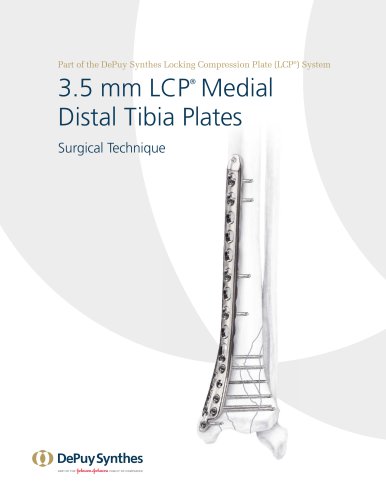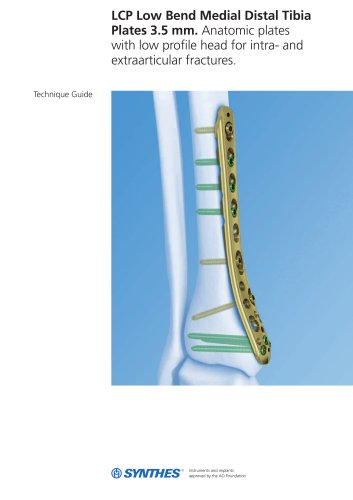
Excertos do catálogo

CEMENTLESS ACETABULAR RECONSTRUCTION Surgical Technique never stop moving- Z^Z^ZZ^L
Abrir o catálogo na página 1
Templating and Pre-Operative Planning 2 Trial Sizing and Impaction of the Shell 5 Trial sizing and Impaction of the Polyethylene Liner 8 Polyethylene Line Extraction 9
Abrir o catálogo na página 3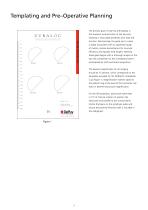
Templating and Pre-Operative Planning npin inrNO niWinai The primary goal of total hip arthroplasty is the anatomic reconstruction of the hip joint, resulting in favourable prosthetic joint load and function. Mechanically, the goals are to create a stable articulation with an optimised range of motion, restore biomechanics for muscular efficiency and equalise limb lengths. Meeting these goals begins with a thorough analysis of the hip with comparison to the contralateral side in anteroposterior (A/P) and lateral projections The desired magnification for all imaging should be 15 percent,...
Abrir o catálogo na página 4
The radiographs should clearly demonstrate the acetabular configuration and the endosteal and periosteal contours of the femoral head, neck and proximal femur (Figure 2). DURALOC templates allow assessment of the most likely size of cup to be implanted. The acetabular component should be placed on structurally sound bone to optimise the opportunity for bone ingrowth. The cup should be placed so that the head centre is as near to the anatomical position as possible and the most inferior part of the cup should normally be at the level of the bottom of the Figure 2
Abrir o catálogo na página 5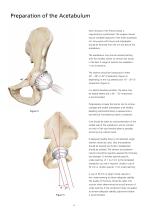
Preparation of the Acetabulum After removal of the femoral head, a capsulectomy is performed. The surgeon should ensure complete exposure of the entire acetabular rim. Any excess soft tissues and osteophytes should be removed from the rim and bed of the acetabulum. The acetabulum may now be reamed starting with the smallest reamer to remove soft tissues in the bed. A range of reamers are available in 1 mm increments. The reamers should be introduced in either 35° – 40° or 45° of abduction (Figure 4), 40˚ - 45˚ depending on the cup selected and 15° – 20° of anteversion (Figure 5). In a...
Abrir o catálogo na página 6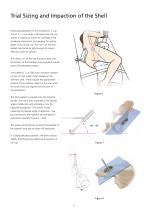
Trial Sizing and Impaction of the Shell Following preparation of the acetabulum, a Cup Trial of 1 – 2 mm larger in diameter than the last reamer is inserted to assess the coverage of the acetabular component and gauging the seating depth of the actual cup. The rim fit of the fully seated trial should be tight enough to make it difficult to alter its position. The inferior rim of the trial should be level with the bottom of the teardrop and its position should match the templated position. The DURALOC Cup Trials have indicators marked on the rim that match those marked on the definitive...
Abrir o catálogo na página 7
Cup Positioning Peer reviewed publications highlight the importance of acetabular component positioning in relation to short and long term outcomes during total hip arthroplasty for all types of bearing materials.1-4 Cup positioning should be varied to optimise fixation, range of motion and dislocation resistance and minimise the likelihood of subluxation, impingement and edge loading. This may be assessed during pre-operative planning, acetabular preparation and cup trialling. Sub-optimal component positioning may lead to edge loading, dislocation, increased wear and polyethylene...
Abrir o catálogo na página 8
Trial Sizing and Impaction of the Shell The cup is oriented so that the rim markers are correctly aligned to ensure the screw holes are positioned in the safe zone for screw fixation. (Figure 9). Apex Hole Joint Stability The seating level of the cup can be verified through the apex hole in the cup after removal of the Impactor (Figure 10).
Abrir o catálogo na página 9
Trial sizing and Impaction of the Polyethylene Liner A trial liner is inserted and the femoral side is prepared. After completion of the femoral side, the screw-in trial liner can be used to assess joint stability and range of motion. If the hip shows a tendency to dislocate, an angled or hooded trial liner can be chosen to provide additional coverage of the head. The optimum position of the hood may be marked with diathermy on the rim of the acetabulum for later reference. The trial liner is removed and the apex hole may be closed using an apex hole plug. Soft tissues at the acetabular rim...
Abrir o catálogo na página 10
Polyethylene Liner Extraction If required, the polyethylene liner can be removed using the polyethylene liner extractor. The blunt jaw is located on the rim of the shell while the ‘claw’ jaw is used to bite into the liner, breaking the seal and allowing extraction to be completed (Figure 14). Warning: An extracted liner should not be re-used.
Abrir o catálogo na página 11
1220-28-148 DURALOC Marathon 10° Liner 28 mm x 48 mm 1220-28-150 DURALOC Marathon 10° Liner 28 mm x 50 mm 1220-28-152 DURALOC Marathon 10° Liner 28 mm x 52 mm 1220-28-154 DURALOC Marathon 10° Liner 28 mm x 54 mm 1220-28-156 DURALOC Marathon 10° Liner 28 mm x 56 mm 1220-28-158 DURALOC Marathon 10° Liner 28 mm x 58 mm Bantam Enduron™ 10° Liners 22.225mm (38 - 46 mm) 1220-28-160 DURALOC Marathon 10° Liner 28 mm x 60 mm 1241-38-526 DURALOC Enduron 10˚ Liner 22.225 mm x 38 mm 1220-28-162 DURALOC Marathon 10° Liner 28 mm x 62 mm 1241-40-526 DURALOC Enduron 10˚ Liner 22.225 mm x 40 mm 1220-28-164...
Abrir o catálogo na página 12
Constrained Enduron Liners 32 mm (52 - 66 mm) 1242-12-527 DURALOC Constrained Liner 32 mm x 52 mm DURALOC Constrained Liner 32 mm x 54 mm DURALOC Constrained Liner 32 mm x 56 mm DURALOC Constrained Liner 32 mm x 58 mm DURALOC Constrained Liner 32 mm x 60 mm DURALOC Constrained Liner 32 mm x 62 mm DURALOC Constrained Liner 32 mm x 64 mm DURALOC Constrained Liner 32 mm x 66 mm Option LPW liners 22.225 mm, 28 mm and 32 mm Available for revisions Apex Hole Eliminators 1246-03-000 Apex Hole Eliminator Cancellous Bone Screws 1172-20-000 Cancellous Bone Screw 6.5 mm x 20 mm Cancellous Bone Screw...
Abrir o catálogo na página 13
References 1. Udomkiat P, Dorr LD, Wan Z. Cementless hemispheric porous-coated sockets implanted with press-fit technique without screws: average ten-year follow-up. J Bone Joint 1. ... Surg. 2002;84A:1195-200. 2. Schmalzried TP, Guttmann D, Grecula M, Amstutz H. The relationship between the design, position, and articular wear of acetabular components inserted without cement and the development of pelvic osteolysis. J Bone Joint Surg. 1994;76A:677-688. 3. Kennedy JG, Rogers WB, Soffee KE, et al. Effect of acetabular component orientation on recurrent dislocation, pelvic osteolysis,...
Abrir o catálogo na página 16Todos os catálogos e folhetos técnicos Depuy Synthes
-
2.0 mm LCP® Distal Ulna Plate
20 Páginas
-
VA LCP ® Distal Radius System
8 Páginas
-
Building on Success
16 Páginas
-
RADIUS OF CURVATURE
3 Páginas
-
Introducing The Variable Angle
12 Páginas
-
HEALIX Anchor™ 3.4 mm
2 Páginas
-
Small Battery Drive II
4 Páginas
-
HEALIX ADVANCE
4 Páginas
-
3.5 mm LCP™ Medial
15 Páginas
-
Titanium Sternal Fixation System
34 Páginas
-
MatrixRIB®FixationSystem
86 Páginas
-
External Midface Distractor System
43 Páginas
Catálogos arquivados
-
2.4 mm VA LCP™
4 Páginas
-
Mandible Trauma Solutions
2 Páginas
-
Power line II
4 Páginas
-
Concorde
28 Páginas
-
LCP Intercarpal
31 Páginas
-
LCS® COMPLETE™
2 Páginas
-
Cementing Total Knee Replacements
12 Páginas
-
CORAIL® Hip System Design Rationale
12 Páginas
-
Synthes TPLO.
8 Páginas
-
SynFix-LR System
56 Páginas
-
ATB Anterior Tension Band Plate
32 Páginas
-
CONDUIT™
15 Páginas
-
Brochure_FINAL
2 Páginas
-
DePuy Synthes
81 Páginas
-
Anspach
3 Páginas
-
Orthopedic Foot Instruments
32 Páginas
-
PINNACLE® Hip Solutions
12 Páginas
-
Corail
24 Páginas
-
GLOBAL Advantage Surgical Technique
32 Páginas
-
S-ROM® NOILES™
68 Páginas
-
TRI-LOCK® Product Rationale
12 Páginas
-
Reclaim Surgical Technique
44 Páginas
-
DESIGN RATIONALE AND SURGICAL TECHNIQUE
28 Páginas
-
PRODUCT RATIONALE AND SURGICAL TECHNIQUE
32 Páginas
-
Speed
2 Páginas
-
attune
80 Páginas
-
HAMMERLOCK® 2
2 Páginas
-
DePuy Glenoid Solutions
2 Páginas
-
Trauma Solutions. Elbow
4 Páginas
-
EG1 ™ HIGH SPEED ELECTRIC SYSTEM
2 Páginas
-
Polar
4 Páginas
-
Alveolar Distractor.
4 Páginas
-
Piezoelectric System
4 Páginas
-
Air Power Line II
6 Páginas
-
LCP Clavicle Hook Plate
4 Páginas
-
TruMatch Pin Guides
16 Páginas
-
P F N A
8 Páginas
-
SKILL, DEDICATION,
16 Páginas
-
Orthopaedics. Overview
20 Páginas
-
Marathon Cemented Cup
20 Páginas
-
REEF Surgical Technique
16 Páginas
-
MatrixNEURO
8 Páginas
-
Anspach XMax
4 Páginas
-
Anspach eMax 2 Plus
4 Páginas
-
Small Electric Drive
4 Páginas
-
Air Pen Drive
4 Páginas
-
Colibri II
4 Páginas
-
Spine
25 Páginas
-
Epoca Shoulder Arthroplasty System
8 Páginas
-
VA-LCP Elbow Plating System Promotional
12 Páginas
-
MultiLoc Humeral Nailing System.
4 Páginas
-
Headless Compression Screws 4.5 & 6.5
28 Páginas
-
Expert Hindfoot Arthrodesis Nail
48 Páginas
-
LCP Distal Fibula Plates
32 Páginas
-
LCP Distal Tibia Plate - Low Bend
24 Páginas
-
TomoFix
60 Páginas
-
Expert Tibial Nail PROtect
16 Páginas
-
Expert Tibia Nail
84 Páginas
-
Sacral Bars
16 Páginas
-
Pelvic C-Clamp
20 Páginas
-
Low Profile Pelvic System
16 Páginas
-
Proximal Femoral (Hook) Plate
24 Páginas
-
LCP
24 Páginas
-
PFNA
112 Páginas
-
HCS 1.5, 2.4, 3.0
36 Páginas
-
LCP Wrist Fusion
32 Páginas
-
LCP Compact Hand
28 Páginas
-
VA-LCP Elbow
48 Páginas
-
Distal Radius
44 Páginas
-
Olecranon
30 Páginas
-
LCP Hook Plate
28 Páginas
-
DHP & Olecranon
4 Páginas
-
LCP S-A
4 Páginas
-
Epoca
4 Páginas
-
Philos
32 Páginas
-
MultiLoc
68 Páginas










